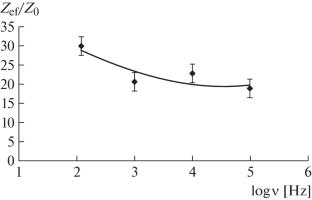恒定电场对从溶液中形成氯磺化聚乙烯薄膜的结构和特性的影响
IF 0.5
Q4 MATERIALS SCIENCE, MULTIDISCIPLINARY
引用次数: 0
摘要
摘要 本文研究了在恒定电场的影响下,从四氯化碳溶液中制备氯磺化聚乙烯(CSPE)薄膜过程中的结构形成特征及其对薄膜性能的影响。研究表明,与在恒定电场外形成的薄膜相比,在恒定电场中形成的薄膜具有更高的电阻和更低的电容、热容量和电损耗正切值。本文章由计算机程序翻译,如有差异,请以英文原文为准。


Influence of a Constant Electric Field on the Structure and Properties of Chlorosulfonated Polyethylene Films during Formation from Solution
The article examines the features of structural formations and their influence on the properties of chlorosulfonated polyethylene (CSPE) films during preparation from solutions in carbon tetrachloride under the influence of a constant electric field. It has been shown that films formed in a directed constant electric field have higher electrical resistance and lower values of electrical capacitance, heat capacity, and electrical loss tangent in relation to films formed outside the field.
求助全文
通过发布文献求助,成功后即可免费获取论文全文。
去求助
来源期刊

Inorganic Materials: Applied Research
Engineering-Engineering (all)
CiteScore
0.90
自引率
0.00%
发文量
199
期刊介绍:
Inorganic Materials: Applied Research contains translations of research articles devoted to applied aspects of inorganic materials. Best articles are selected from four Russian periodicals: Materialovedenie, Perspektivnye Materialy, Fizika i Khimiya Obrabotki Materialov, and Voprosy Materialovedeniya and translated into English. The journal reports recent achievements in materials science: physical and chemical bases of materials science; effects of synergism in composite materials; computer simulations; creation of new materials (including carbon-based materials and ceramics, semiconductors, superconductors, composite materials, polymers, materials for nuclear engineering, materials for aircraft and space engineering, materials for quantum electronics, materials for electronics and optoelectronics, materials for nuclear and thermonuclear power engineering, radiation-hardened materials, materials for use in medicine, etc.); analytical techniques; structure–property relationships; nanostructures and nanotechnologies; advanced technologies; use of hydrogen in structural materials; and economic and environmental issues. The journal also considers engineering issues of materials processing with plasma, high-gradient crystallization, laser technology, and ultrasonic technology. Currently the journal does not accept direct submissions, but submissions to one of the source journals is possible.
 求助内容:
求助内容: 应助结果提醒方式:
应助结果提醒方式:


